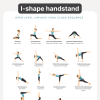
It seems like yoga is the suggested solution by health professionals for many problems that arise nowadays. If you have a cold, your general practitioner may encourage yogic breathing exercises to clear your sinuses. If you’re experiencing trouble sleeping, a sleep expert may introduce you to nightly asana flows to help wind down your body and mind. Back pain? Your chiropractor may direct you to a class to engage in forward folds and deep stretching. Racing thoughts? Consider the benefits of pranayama coupled with the movement that various styles offer to calm your anxious brain – a therapeutic release that I highly recommend as a certified yoga instructor.
Yoga can significantly help curb varying mental and physical symptoms, but these approaches do not have to be practiced in a studio to demonstrate the advantages. I’ve compiled six ways to incorporate yoga into your routine without rolling out your mat in honor of National Yoga Month because you can practice yoga anywhere, anytime.
1. Focus on your posture
I recently had a student confess how much their posture had improved since committing to a regular yoga practice. He proudly stood tall and detailed the changes he noticed in his posture. It delighted me to hear that he was benefiting from my classes each week; however, improving your posture can also happen off the mat.
The way we sit, stand, and walk affects our musculoskeletal system long-term and should be monitored during everything we do – not just while sitting up tall in an easy seat. Focus daily on your posture while driving, typing on the computer, scrolling through your phone, and walking your dog, and you will see growth over time.
2. Develop a deep breathing practice
Many breathing exercises can be observed outside the walls of a yoga studio. There is no magical spell that consumes you upon walking into a class that is essential to develop a deep breathing practice. This can be done on your own, without the instruction of a teacher standing before you.
You can try simple breathing exercises, which can help reduce any distractions or strains on the body by imagining the breath traveling through the body with every inhalation and exhalation. There is also abdominal breathing – an ideal exercise for stimulating a relaxation response through your breath. Or alternate nostril breathing – which helps center your mind and body (and clears the sinuses for those cold sufferers). These exercises can be practiced anywhere that allows a quiet space and room to breathe.
3. Be compassionate and patient towards others
One reason yoga is encouraged is for its teachings of compassion and patience. Students are inspired by moving through each posture calmly without rushing from one pose to the next. The flowing nature teaches you to be compassionate and patient towards yourself and others – trusting the process without judgment or blame.
This can be translated off of the mat as well in our everyday lives. Treating others with kindness and decency embodies this practice, perhaps when in line at the grocery store or when driving in rush hour traffic. Getting in the habit of slowing down and being gracious towards others is an example of yoga.
4. Live in the present moment
When you live in the present moment, you are canceling all outside influences, bringing your attention inward to what is happening here and now. I frequently instill this mindset with my students to concentrate on their own experiences rather than the uncontrollable occurrences around them.
We often don’t appreciate what’s existing in the present moment because we fantasize about the future and daunting tasks of the past, which is why this guidance is essential to our daily routines. Channel this awareness in every activity to acknowledge the moment you’re in with gratitude.
5. Maintain balance
Your intention to attend a yoga class is most likely for the endless benefits that participating has to offer (I’ve already listed many that yogis can’t resist). But it’s also because yoga helps you maintain balance in your day-to-day lives. The practice supports a regimen dedicated to your well-being and grants time away from your other obligations (work, kids, chores, etc.). But just because you are not in a studio chanting AUM with a group of like-minded yogis doesn’t mean you can’t practice this elsewhere.
You can still maintain balance by separating the tasks that need to get done and the hobbies you enjoy doing. Creating boundaries for yourself and treasuring the time spent on your health is a significant component of yoga. And we all end in Savasana at bedtime.
6. Be mindful of the treatment of your mind and body
Before discovering yoga, it didn’t occur to me that my actions could harm my health. The food that I ate, the content that I consumed, and the people I surrounded myself with could play a part in how I felt. I didn’t worry about my behavior’s detriment on me because I was not aware of the damaging influences they had on my health.
Once I altered my thinking, I was introduced to a different perspective on my life – one where I honored and respected the gifts that I was given. Even when off the mat, you must be mindful of the treatment of your mind and body because it is your most cherished sense of being. Do this by paying mind to what you choose to read, the conversations you divulge in, the nutrients you fuel your body with, and the words you direct towards yourself. These factors are fundamental contents of yoga that you can practice everywhere you go.
It’s easy to incorporate yoga into your days, even if you don’t have a mat or a studio accessible to you. A lot of what I teach in my classes are guidelines to be used beyond the hour class time. Let National Yoga Month be your inspiration to blend yoga into your everyday lifestyle both on and off the mat.










